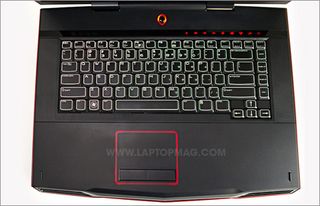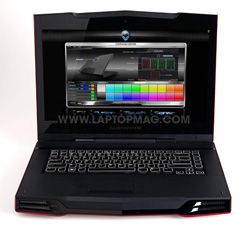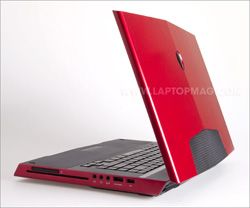Laptop Mag Verdict
This 15-inch beast of a gaming rig is tops in all categories--including price.
Pros
- +
Blazingly fast
- +
Cool design
- +
Gorgeous full HD display
- +
Crisp, smooth Blu-ray playback
- +
Customizable lights
Cons
- -
Expensive
- -
Mediocre speakers
Why you can trust Laptop Mag
Following the redesign of its 17-inch gaming notebook flagship, Alienware went and gave the same extreme makeover to the M15x, its newest 15-inch notebook. Not only does this monster have the same intimidating looks as the M17x--a menacing grille and colored backlit keyboard--but, outfitted with an Intel Core i7 processor, it shattered a number of our benchmarks. Of course, like every Alienware machine, the M15x doesn't come cheap (starting at $1,499, $2,574 as configured), but if you have the means you won't be disappointed.
Design
Like the M17x, the front of the M15x has the angular looks of the redesigned Chevy Camaro. Our system had a Nebula Red finish, but it's also available in Lunar Shadow (silver) and Cosmic Black. The red coloring only extends as far as the outer lid, sides, and chassis, so the inside and front of the system is black. The magnesium-alloy chassis is a departure from that of its predecessor, the Area-51 M15x, which experienced an issue with the plastic frame cracking due to overheating issues. Still, it adds to the size; this 14.9 x 12.2 x 1.9-inch heavyweight checks in at 9.0 pounds--and that's without the AC adapter.
There aren't any visible screws anywhere but on the customized aluminum name plate, which resides on the underbelly of the beast. Alienware managed to cram customizable color lights in several places, including the Alienware logo below the 15-inch (1920 x 1080-pixel resolution) display, along the touchpad, under the keyboard, on the Alienware head-shaped power button, and even on the back of the lid. The end result is that the M15x makes a very strong impression even before you fire up a single game.
Keyboard and Touchpad
The chunky keys on the M15x don't have any flex to them, so it's as if you're typing on a legitimate desktop keyboard. Unlike the larger M17x, there's no number pad, so you'll have to use other keys to store all of your macros in games such as World of Warcraft. As mentioned, you can tweak all of the colored lights on the notebook, and Alienware even lets you adjust the keyboard by region. So, for example, you can have the far left of your keyboard glow blue, the middle-left glow red, the middle-right glow orange, and the far right glow green. It reminded us of a rainbow snow cone. Regardless of whether you stick with any particular pattern, it's fun to experiment with all the possible combinations.
Above the keyboard are soft-touch buttons for ejecting Blu-ray discs, full media controls for skip and play/pause, volume controls, a wireless launch button, and quick-launch buttons for the system's AlienFusion control panel (one for controlling lights and another for its power-tweaking Stealth mode).
The touchpad on the M15x is large and flush with the wrist rest, except for a small glowing border; its honeycomb texture allows for swift finger glides across the surface. The two touchpad buttons provided good feedback, but if you're playing a first-person shooter you'll want to use a gaming mouse for quicker button presses.

Click to enlarge
Display and Audio
The 15.6-inch, 1920 x 1080-pixel display on the M15x is nothing short of glorious. The edge-to-edge glass gives the system a sleek look, and while it kicked back some reflections, they weren't much of a bother, even in nighttime scenes while playing games. The display was amazingly crisp and had great contrast; when watching a Blu-ray of Monsters, Inc., we could make out each individual strand of hair on Sulley (the monster voiced by John Goodman), and were impressed at how they waved when the character moved about.
Audio from the two front-mounted speakers was loud, but we were disappointed with their quality. When streaming music over Pandora (such as Eric Clapton's "Five Long Years"), there was a lack of bass, and music had a tinny sound to it, even after adjusting the equalizer settings using the IDT Audio Control Panel. For this amount of money, we expected more. However, there was enough sound separation between the two speakers that we could hear and anticipate enemies coming toward us from either side when playing games such as Left 4 Dead.
Ports and Webcam
While the M15x has a good number of ports, we were surprised to see some omitted. On the left side of the unit are a DisplayPort for digital video, VGA, Ethernet, one USB, FireWire, and a 4-in-1 memory card reader. On the right is an ExpressCard/54 slot, two headphone, mic, USB, and a USB/eSATA combo port that can recharge devices even when the M15x is turned off. At this price point (and on this large of a chassis), we would have expected the more common HDMI as well. Unlike the M17x, the charging port is located on the left side of the M15x.
The 2-megapixel webcam on the M15x returned excellent images; over Skype, a caller could clearly make out our beard stubble and the shininess of our hair.
Performance

Click to enlargeWhen it came to our traditional benchmarks, the Alienware M15x performed about as we expected. Which is to say, it kicked ass. On PCMark Vantage, which measures overall system performance, the M15x scored 6,543, surpassing every other production notebook we've tested. It beat out the M17x (which uses a 2.53-GHz Intel Core 2 Duo QX9300 CPU and 8GB of RAM) by almost 1,300 points, and the Toshiba Qosmio X505 by about 1100 points (which has an Intel Core i7 720QM, 6GB RAM, and a 64GB SSD). Needless to say, it left the desktop replacement average (3,885) in the dust.
Booting into Windows 7 Ultimate, the M15x took a not-unreasonable 58 seconds. On our LAPTOP Transfer Test (copying 4.97GB of multimedia files), the M15x's 7,200-rpm, 250GB drive notched 27.5 MBps; that's around 5.0 MBps faster than the category average, but just under 10.0 MBps slower than the M17x.
Graphics Performance
Alienware didn't put the most powerful graphics card it could have in the M15x, which showed in its 3DMark06 score of 11,662. While the Nvidia GeForce GTX 260M GPU and 1GB of video memory is certainly strong (it almost doubled the category average), it doesn't compare to the dual GTX 280M GPUs in the M17x, which notched 13,463. However, the M15x handily beats out the GTS 250M graphics in the Qosmio X505. In 3DMark Vantage, the M17x pulled even further away, scoring 11,904 to the M15x's 5,719. Even the ASUS W90 scored a better 8,399 in this test.
Video Transcoding
When we transcoded a 5-minute-and-5-second MPEG-4 file to AVI using HandBrake, the M15x took 2:40; that's less than half the category average (6:02), and about 20 seconds faster than both the Toshiba Qosmio X505 and ASUS G51J. We then converted the same file using vReveal, a CUDA-enabled application. In this, the Qosmio X505 performed the best, finishing in 1:29, almost a minute faster than the M15x.
Lastly, we used Oxelon Media Converter, an application that's capable of multithreading and can effectively use all four cores the M15x has to offer. In this test, the M15x finished in 54 seconds; that's 4 seconds faster than the Qosmio X505, and 7 seconds faster than the ASUS G51J.
Gaming Performance
Of course, the M15x is designed to play games, and play them well. In Far Cry 2, we averaged 113 frames per second with the resolution set to 1024 x 768, and graphics set to optimal. This almost doubles the category average, and beat out everything else--the M17x and ASUS G51J came closest, both notching 99 fps. Likewise, when we cranked the resolution up to native (1920 x 1080 in the case of the M15x) and set the graphics to Very High, the notebook was still able to register a very playable 41 fps. While it couldn't touch the M17x (69 fps), the latter system utilized dual GTX 280M graphics cards.
When it came to other games, the M15x was excellent, too. In Call of Duty: World at War, we averaged 42 fps with the resolution set to 1920 x 1080; running through Pacific island jungles, action was smooth and crisp. We also had equal success running Left 4 Dead, where we had an average frame rate of 56 fps in full HD. In Batman: Arkham Aslylum, the frame rate dropped to 37 fps, but was still very playable. Batman's cape flowed smoothly through the air as we spin-kicked perps inside the insane asylum.
Battery Life and Wi-Fi
We didn't expect much endurance out of the 9.0-pound M15x, but given its relative portability compared to the M17x, we were hoping for a longer runtime out of its six-cell battery. Using the LAPTOP Battery Test, the M15x mustered 1 hour and 24 minutes of unplugged computing. Still, this notebook managed to last slightly longer than the ASUS W90, and just 10 minutes less than the M17x.
We doubt that you'll stay unplugged for long, but if that's your prerogative, you can purchase a nine-cell battery for $100.
The Intel WiFi Link 5300 802.11/a/g/n card delivered throughput of 17.8 Mbps at 15 feet, and 14.2 Mbps at 50 feet. That's a bit below this category's Wi-Fi averages of 20.0 Mbps at 15 feet and 16.4 Mbps at 50 feet. Normally, this difference wouldn't be much of an issue, but a higher throughput is essential when playing games at LAN parties.
Greenness

Click to enlargeGoing in, we knew that the M15x is not for the conservation-minded; in order to get this sort of performance, you need to draw a lot of power. It took 2 hours and 19 minutes to fully recharge the M15x's six-cell battery. During that time, the notebook used 9882.9 watts. When divided by the battery life (to determine the LAPTOP Battery Efficiency Rating), the M15x scored 117.7; that's about twice the average for desktop replacements (where less is better), and it comes in third highest overall, after the M17x (125.2) and the ASUS G51J (121.5).
Configurations
A base unit of the M17X ($1,499) comes with a Cosmic Black lid (our Nebula Red is a $99 upsell), a 1.6-GHz Intel Core i7-720QM processor, Windows 7 Home Premium, Nvidia GeForce GTX 240M graphics (with 512MB of memory), a 1600 x 900-pixel resolution display, 3GB of RAM, a 250GB hard drive, and a dual-layer DVD burner.
If money is no object, customers can opt for the Nebula Red finish, a 2.0-GHz Core i7-920XM CPU, Windows 7 Ultimate, Nvidia GeForce GTX 260M graphics (with 1GB of memory), a full HD display, 8GB of RAM, a 256GB solid state drive, and a Blu-ray burner; that brings the price to $4,598--about as expensive as the M17x we reviewed.
Software and Support
Unlike many notebooks these days, Alienware doesn't preload the M15x with useless trialware that slows down the system; the only software we found on the notebook was Command Center, needed to tweak lights and power settings, Alienware Respawn (to restore the system), Dell DataSafe, CyberLink PowerDVD 8 and YouCam, and Nero SmartStart Essentials.
Alienware offers a one-year limited hardware warranty with each purchase, and 24/7 online and phone support.
Verdict
The Alienware M15x is undoubtedly the fastest 15-inch gaming notebook we've tested, and its looks match its performance. However, other rigs offer better bang for your buck. For example, the ASUS G51J-A1 may not have the cool backlit keyboard, edge-to edge display, or a Blu-ray player, but it gets comparable gaming scores, and costs $1,100 less. Nevertheless, if you want the best-looking and best-performing 15-inch rig on the block, this is the notebook to get.
Alienware M15x Specs
| Bluetooth | Bluetooth 2.1 |
| Brand | Alienware |
| CPU | 1.73-GHz Intel Core i7-Q820 |
| Card Slots | 8-1 card reader, ExpressCard/54 |
| Company Website | http://www.alienware.com |
| Display Size | 15.6 |
| Graphics Card | Nvidia GeForce GTX 260M |
| Hard Drive Size | 250GB |
| Hard Drive Speed | 7,200rpm |
| Hard Drive Type | SATA Hard Drive |
| Native Resolution | 1920x1080 |
| Operating System | MS Windows 7 Ultimate |
| Optical Drive | BD-ROM/DVD /-RW |
| Ports (excluding USB) | Firewire, eSATA/USB, DisplayPort, VGA, Microphone, Headphone |
| RAM | 4GB |
| RAM Upgradable to | 8GB |
| Size | 14.9 x 12.2 x 1.9 inches |
| USB Ports | 3 |
| Video Memory | 1GB |
| Warranty/Support | One-year limited, in-home service/24/7 toll-free phone |
| Weight | 9.0 pounds |
| Wi-Fi | 802.11a/g/n |
